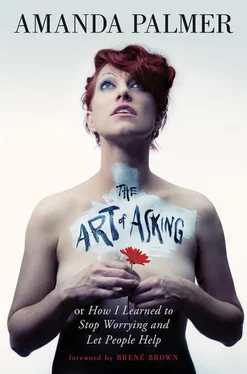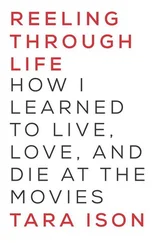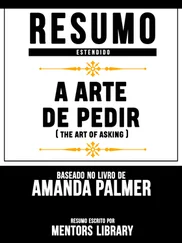The perception that vulnerability is weakness is the most widely accepted myth about vulnerability and the most dangerous. When we spend our lives pushing away and protecting ourselves from feeling vulnerable or from being perceived as too emotional, we feel contempt when others are less capable or willing to mask feelings, suck it up, and soldier on. We’ve come to the point where, rather than respecting and appreciating the
courage and daring behind vulnerability, we let our fear and discomfort become judgment and criticism.
Following this logic, we can assume that the likelihood of someone yelling GET A JOB from their passing car is indirectly proportionate to their own crippling fear about getting up on the figurative box themselves.
Or to strip it down to its essence:
Hate is fear.
• • •
I broke up with Joseph.
My boyfriend Jonah would stop by sometimes to watch me statue-ing. He played the cello.
I loved giving flowers to people I loved.
I’d saved $400 to buy a ticket to go on a vacation with him and his family, and I’d given him the cash to book my flight along with theirs. But then we started breaking up, and we decided that I shouldn’t go in the middle of our off-again-on-again drama; it would be too awkward.
I’d had a good day of Bride-ing: some nice guy had hand-folded me an origami crane, which I had tucked in the folds of my dress, Jonah had come by to blow me an on-again kiss and say hello, and it had rained but only for about two minutes, so I didn’t get too wet. I went down the stairs to the basement of Toscanini’s to sit on the dark brick floor and count my hat for the day, and to my astonishment, there was a wad of cash wound up in a rubber band. I ran upstairs and grabbed the shop telephone and called Jonah.
You’re never going to believe this but somebody put FOUR HUNDRED DOLLARS in my hat today .
Oh, Amanda , he said.
What? It’s amazing! Can you believe someone cared that much?
Oh, Amanda .
What?
Oh… Amanda .
WHAT?
• • •
Lewis Hyde published a beautiful dot-connecting book in 1983 called The Gift , which tackles the elusive subject of what Hyde calls “the commerce of the creative spirit.”
He explains the term “Indian Giver,” which most people consider an insult: someone who offers a gift and then wants to take it back. But the origin of the term—coined by the Puritans—speaks volumes. A Native American tribal chief would welcome an Englishman into his lodge and, as a friendly gesture, share a pipe of tobacco with his guest, then offer the pipe itself as a gift. The pipe, a valuable little object, is—to the chief—a symbolic peace offering that is continually regifted from tribe to tribe, never really “belonging” to anybody. The Englishman doesn’t understand this, is simply delighted with his new property, and is therefore completely confused when the next tribal leader comes to his house a few months later, and, after they share a smoke, looks expectantly at his host to gift him the pipe. The Englishman can’t understand why anyone would be so rude to expect to be given this thing that belongs to him .
Hyde concludes:
The opposite of “Indian giver” would be something like “white man keeper”… that is, a person whose instinct is to remove property from circulation… The Indian giver (or the original one, at any rate) understood a cardinal property of the gift: whatever we have been given is supposed to be given away again, not kept… The only essential is this:
The gift must always move.
• • •
And then there was Lee.
I was going crazy in my crappy Somerville share house; my roommate and I were ready to kill each other. I wanted, secretly, to start some kind of freaky art commune, but I had about $300 to my name and no idea where to start. Instead, I stumbled into one that already existed when Rob Chalfen, my local coffee-shop friend who boasted Cambridge’s largest collections of New Directions paperbacks and old-time jazz on vinyl, invited me to his friend’s going-away party at a commune-collective across the river in Boston proper. He knew I was art-house hunting and thought I might be able to finagle my way in the door.
The Cloud Club is a four-story brick townhouse wrapped protectively in a winding vine of leafy wisteria, the root of which is as wide as a human torso and curves smack across the huge oak front door, hanging low enough that you have to duck under to get inside.
I walked up a winding, rickety staircase into a hallway covered with faded mirrors, surreal drawings, and blinking Christmas lights. Empty gilded frames and upside-down paintings hung at odd angles. A crowd was gathered in a cozy, low-lit kitchen warmed by a wood-burning fireplace with fixtures from the 1890s. All around me were the clinking of glasses, the lighting of cigarettes, and the buzzing conversation of musicians, filmmakers, sex workers, activists, and painters.
On the top floor, in a room brimming over with antlers, plants, swords, and old hooked rugs, the party was in full swing. Guests used a huge tree situated in the middle of the room to climb up to a bedroom loft capped with a handmade glass geodesic dome; a sliding door led to a roof covered with discarded sinks and rotting sculptures that overlooked the glittering Boston night skyline. And the crown jewel: in the corner of the room was a rickety spinet piano. I took a deep breath. I was home.
Rob introduced me to Annie-the-writer, the woman who was going away, and I mentioned to her that I was looking to rent an apartment. Was this one available?
Go talk to Lee . She laughed. It might be .
I passed through a hallway of billowing, spiraling, white plaster shapes hand-sculpted onto the walls, and through a set of double doors that looked like they had been repurposed from a fin de siècle Parisian bar. I was so in love with this house already, I wanted to kiss every floorboard and mismatched doorknob. I grew up in a collapsing Colonial fixer-upper that my parents spent the entirety of my childhood trying to make heatable and habitable. This place felt as familiar to me as my own fingers.
I knocked tentatively, went in through the door, and there, engulfed in a cave-like room stuffed with anthropomorphic sculptures and piles of spiral notebooks, was Lee, seated on one of his own hand-carved chairs, writing a little sign on a piece of yellowed paper that said, “Room for Rent, Market Price or DISCOUNT FOR VISIONARY ARTISTS.” Clearly he was planning on taking it down to the party and posting it on Annie’s door. He looked like Gandalf in a cowboy hat, with a kindly smile, a flowered shirt, a huge, white beard, and the kind of rugged, careful hands that had done a lot of heavy lifting and intricate craftsmanship.
WAIT , I said.
Yes? he said, looking up and smiling.
DON’T WRITE THAT SIGN .
Why not? he asked.
I’M HERE. I’M MOVING IN .
At this, he giggled, took my phone number, and told me to come back tomorrow.
We’ll see , he said.
Lee didn’t just accept tenants off the bat, even when they came referred by friends. You had to show up with luggage, hang out and chat with him for some unspecified period of time, and then, only after you had passed what my future housemates would come to refer to as the “mystery aesthetic” test, would you be allowed to consider yourself an official member of the household.
I showed up the next day with two boxes of clothes, a toothbrush, and a pile of books, determined never to leave. It worked.
Читать дальше












